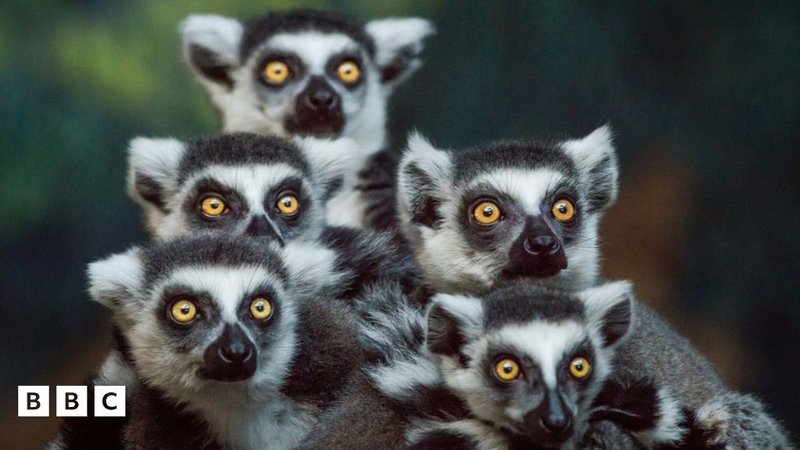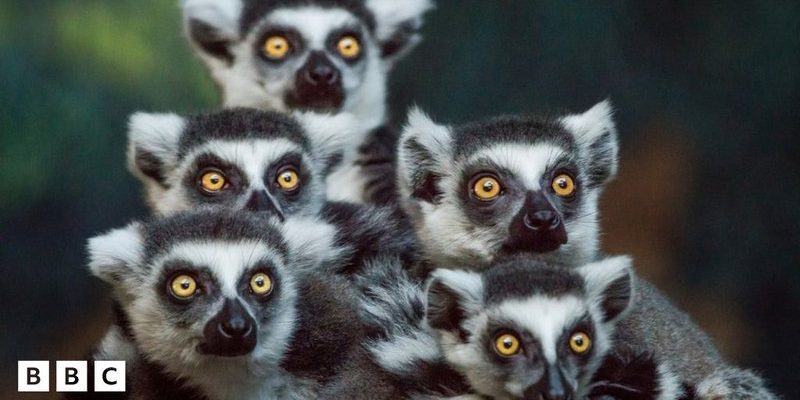
Let’s dive into a world of furry friends that resemble the Indri. We’ll explore ten animals that share either physical traits, habitats, or behaviors with this charming lemur. You might be wondering what sets them apart and how to recognize these wonderful creatures in the wild. Don’t worry; I’ll guide you through each one, explaining what makes them unique while also highlighting their similarities to the Indri.
1. The Sifaka
The Sifaka is another type of lemur found in Madagascar and is a close relative of the Indri. With its long limbs and big, expressive eyes, it almost looks like it’s ready to dance. Sifakas are known for their unique way of moving—they leap from tree to tree with grace. Much like the Indri, they have a loud call that echoes through the forests.
What sets the Sifaka apart is its coat, which can be a mix of white and brown. While both the Sifaka and Indri have similar body structures, the Sifaka’s coat is more varied, and its vocalizations differ slightly. If you spot one, you might notice the way it seems to glide through the air, which is a different style compared to the hopping Indri.
2. The Ring-Tailed Lemur
When it comes to charisma, the Ring-Tailed Lemur is hard to beat. With its signature black-and-white ringed tail, it’s likely the most recognizable lemur. While it doesn’t have the same vocal power as the Indri, its social behavior is quite fascinating. Ring-Tailed Lemurs live in groups, often grooming each other and creating strong bonds.
In contrast to the Indri, the Ring-Tailed Lemur has more pronounced features and a different coloration. Its tail is long and bushy, which it uses for communication within its troop. If you come across this lemur, you’ll notice how its size and appearance differ—but both are equally enchanting in their own ways.
3. The Aye-Aye
The Aye-Aye is one of the strangest-looking animals you might ever encounter. This nocturnal lemur has large eyes and an elongated middle finger used for tapping on trees to find insects—a behavior that’s a bit different from the Indri’s lifestyle. The Aye-Aye is also smaller, with a thin body and a shaggy coat that gives it a ghostly appearance at night.
While the Indri is known for its daytime activities and socialization, the Aye-Aye is more of a loner. Its unique adaptations make it fascinating, but you won’t see it leaping through trees in the same way. If you spot an Aye-Aye, take a moment to appreciate its quirks—it’s like meeting a distant cousin with a wildly different story.
4. The Black Lemur
The Black Lemur is another lemur found in Madagascar but with stark differences in appearance and behavior. Males have a glossy black coat, while females are brown. This gives them a beautiful contrast, but it’s their eyes—golden in color—that really catch your attention.
Unlike the Indri, which is known for its loud calls, the Black Lemur communicates through a variety of sounds, from growls to whistles. Their social structure is also unique; they live in smaller family groups. Recognizing a Black Lemur isn’t difficult if you pay attention to its color and vocalizations—both are quite distinct from the Indri.
5. The Common Marmoset
Moving beyond Madagascar, the Common Marmoset offers a different perspective. Although it’s not a lemur, this small primate shares some traits with the Indri, like being incredibly social. Marmosets have a fuzzy appearance and a playful nature, often seen jumping around in trees in small groups.
The key difference is their size and habitat. Common Marmosets are much smaller and native to South America. They also have a different diet, mostly feeding on insects and fruit. If you’re in the right forest habitat, witnessing their energetic antics can be a joyful experience, but don’t expect them to possess the same vocal capabilities as the Indri.
6. The Tarsier
The Tarsier might seem like a small, adorable creature, but it’s a primate that brings a lot of unique traits to the table. With enormous eyes and a nocturnal lifestyle, tarsiers are quite different from the daylight-loving Indri. Their long limbs enable them to leap impressively between branches, similar to how Indris move, but with a style all their own.
A tarsier’s diet is primarily made up of insects, and they’re known for their remarkable head-turning ability—almost 180 degrees! This fascinating trait sets them apart visually and behaviorally from the Indri. If you spot one during the night, you’ll quickly see how its adaptations help in a different kind of environment.
7. The Galago (Bushbaby)
Often seen as a cuter cousin of the tarsier, the Galago or Bushbaby is another small primate that shares some traits with the Indri. Found in Africa, these adorable creatures have large eyes and powerful legs, allowing them to jump great distances. Their vocalizations can be a bit similar to the Indri’s calls, often making nighttime a symphony of sounds.
However, Galagos tend to be smaller and have a different social structure. While Indris might be more solitary or in pairs, Galagos often live in family groups. They also have a distinct coat of fur that varies in color. If you’re out in the wild, hearing a Bushbaby can be just as thrilling as spotting an Indri, but be ready for a smaller, more agile friend!
8. The Slow Loris
The Slow Loris is a unique primate with a reputation for its slow, deliberate movements. While it’s not a lemur, it shares the same tree-dwelling lifestyle as the Indri. Found in Southeast Asia, slow lorises have big, round eyes that can be quite mesmerizing.
What makes them stand out is their toxic bite, which is very unusual for primates. While the Indri is more about agility and vocalization, the Slow Loris takes a completely different approach with its stealthy movements and unique defense mechanisms. Spotting one might leave you in awe, but don’t expect the same energetic interactions you’d get with an Indri.
9. The Cottontop Tamarin
The Cottontop Tamarin is a small primate known for its distinctive fluffy white hair and tiny size. Native to Colombia, these little guys are highly social, similar to how Indris can be. They often travel in family groups, making their interactions quite lively.
Yet, where the Indri boasts a robust, lemur-like appearance, the Cottontop Tamarin is dainty. Their diet consists mainly of fruit and insects, differing from the Indri’s broader feeding habits. If you see a Cottontop Tamarin, you’ll be charmed by its playful nature, though it won’t sing out like an Indri!
10. The Spider Monkey
Last but not least, we have the Spider Monkey from Central and South America. While they look quite different from the Indri, they share a tree-dwelling lifestyle. Spider Monkeys are known for their long limbs and prehensile tails, which aid them in swinging through the canopy with ease.
Unlike the Indri’s short, strong limbs designed for leaping, Spider Monkeys are superb acrobats. Their vocal calls are more varied and often echo through the jungle. When you witness a Spider Monkey in action, you’ll see just how different their climbing and swinging techniques are, giving you a fresh perspective on primate lifestyles.
By now, you should have a better understanding of the diverse creatures similar to the Indri, ranging from lemurs to other primates. Each animal has its own distinct features and behaviors that make them special. So, the next time you’re in Madagascar or even the nearby regions, take a moment to appreciate these magnificent creatures and what sets them apart from the Indri. Nature’s variety is truly a wonder, and each encounter can be memorable and enlightening!

